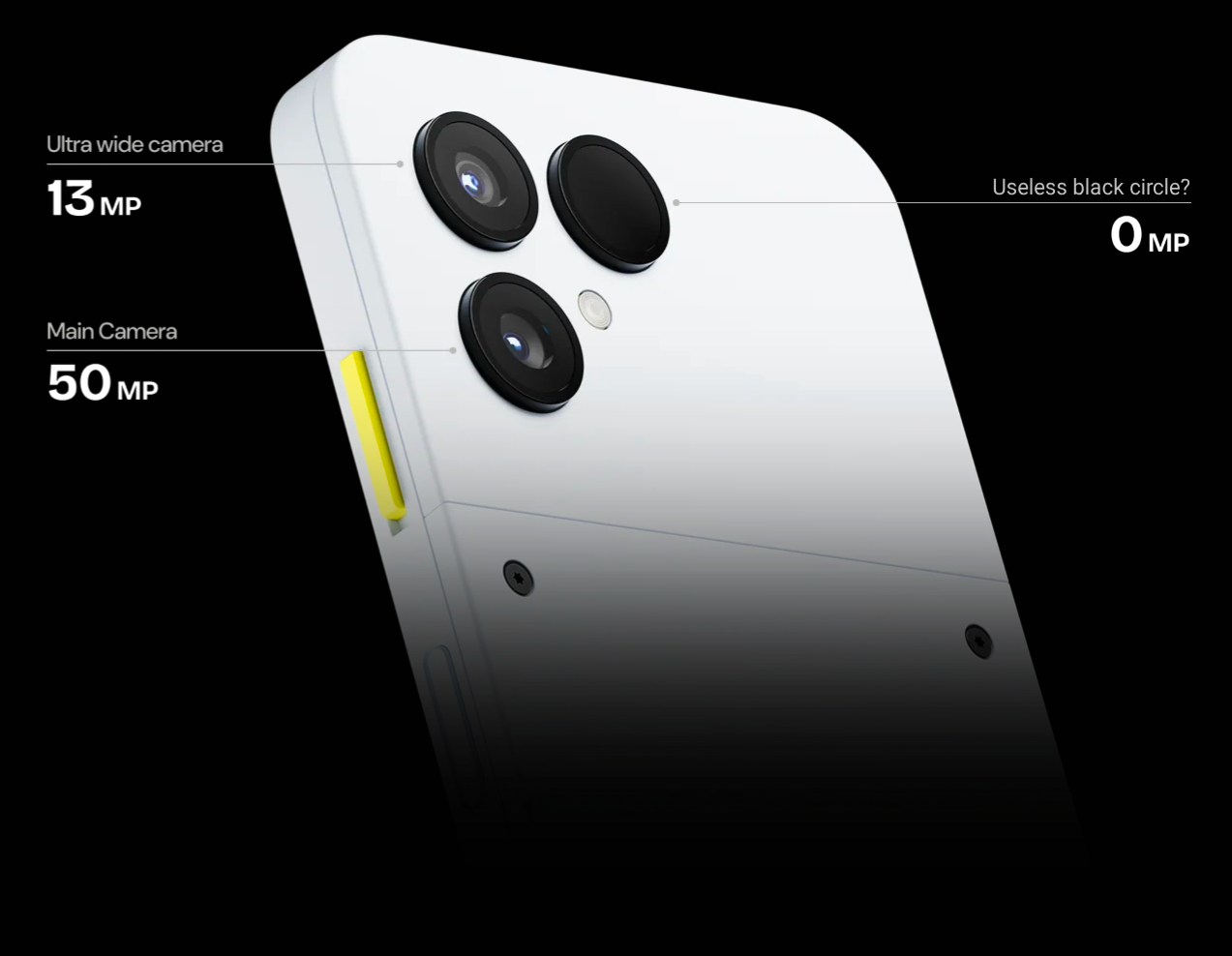Fairphone announces the €599 Fairphone 6, with a 6.31" 120Hz LTPO OLED display, a Snapdragon 7s Gen 3 chip, and enhanced modularity with 12 swappable parts
-
Read through the whole report, sum up all the money they mention. It comes out to $16 000. Double that for the stuff where they don't mention money (because they surely would mention anything that costs more than the things they do mention). Double it again, for a safety margin. Double it again, because we are really generous. Now we are at €128 000. Divide that by the number of devices sold in 2024 and you get $1.24. Now add the $1.20 (Page 29) they pay as a living wage bonus and you arrive at $2.44 per device.
And now let's be super generous and double that guess again, and you end up with the <€5 per device that I quoted above.
The picture becomes clearer when you look at what they say about their fair material usage.
Take for example the FP5 (page 42 & 67). Their top claim here is "Fair materials: 76%", which they then put a disclaimer next to it, that they only mean that 76% of 14 specific focus materials is actually fair. On the detail page (page 67) they specify that actually only 44% of the total weight of the phone is fairly mined, because they just excluded a ton of material from the list of "focus materials" to push up the number.
The largest part of these materials are actually recycled materials (37% of the 44% "fair" materials). The materials they are recycling are plastics, metals and rare earth elements. That's all materials that are cheaper to recycle than to mine. You'll likely find almost identical amounts of recycled materials in any other phone, because it makes economical sense. It's just cheaper. Since these materials cost nothing extra to Fairphone, we can exclude them from the list, which leaves 1% of actually fair mined material (specifically gold), and 6% of materials that they bought fairwashing credits for.
Also, the raw materials of phones are dirt cheap compared to the end price. The costly part is not mining the materials, but manufacturing all the components.
With only 1% of the materials being fairly mined and only 6% being compensated with credits, you can start to see why in total they spend next to nothing on fair mining/fair credits.
Thanks for the detailed reply. You saying that "They themselves claim that they don’t spend more than €5 per phone on fair trade or environmental stuff" is a complete lie. It's not a number they're claiming, it's a number you've estimated. And lets be clear: what you've done is take $3k in gold credits plus $13k cobalt credits and multiplied that by an arbitrary 8x.
I think you've gone into your analysis with a foregone conclusion. There simply isn't enough information to say anything about the cost overheat of being "fair".
You’ll likely find almost identical amounts of recycled materials in any other phone, because it makes economical sense. It’s just cheaper.
And yet the FP4 was significantly less recycled. Plastic is certainly not cheaper to recycle; that's a lie the plastic industry's been pushing for a while.
-
This post did not contain any content.

For real, though, what is it?
-
I've never met someone that cared about a thinner phone, they've been too thin since 2015..
People that want their ducking hradphine jacks? They are everywhere.
Do you interact with people outside of audiophile circles? I'm not in any, and I haven't heard anyone in person complain about a missing headphone jack in many years, not after a few years of airpods being available. Hell, I don't know anyone who uses wired headphones anymore. I have heard people mention that my phone is too heavy, and I'm using a pixel 9 pro. Before this phone I was using a pixel 5, and I had people telling me my phone was too small/plastic-y. I don't think you have an understanding of "normal people" They aren't tech enthusiasts, they aren't audiophiles, and they are genuinely shocked when I tell them about how egregiously most tech companies are violating their privacy, but are quick to say that they don't care/don't want to give up creature comforts to prevent it.
-
Just out of interest, because I too love the jack, then what are you buying in the future?
I have a Sony Xperia that has both a jack and a SD slot. I shelled out for the top of the line one, but since it has good specs I plan on keeping it for many years.
-
Okay, I'm going to ask... why don't you use wireless?
Edit: some results are in, and the only reasonable answer is better audio quality, although that's probably no longer true. The rest are fairly weak reasons.
Lol'd at the 10m extension cord though, thanks for that one.
It's about options. You can still use Bluetooth even with a phone that has a 3.5mm jack. I also run live sound and have used the ability to plug my phone directly into the board for background music multiple times.
-
Battery degradation. Wired earphones/headphones can be BIFL if treated properly. A typical wireless device will see battery degradation within a handful of years, and I have yet to see a decent TWS solution with replaceable batteries.
The Fairbuds does have a replaceable battery if that's what you are searching for. Sure, the sound won't be as good as a Sony, Bose, or the like, but it would be good enough if your focus is durability instead of perfect sound quality.
-
I’m assuming they are removing the headphone jack cause the internal components take up too much space. I can’t imagine these companies removing the jacks cause they cost too much money.
You're vastly overestimating the space required for a 3.5mm jack, and the reasons for its removal.
The jack takes up some internal space, but not much at all. The components required internally like the DAC chip are insignificant. It is a potential source of water ingress, but that can be mitigated and has been done many times before.
The reason for removal is two fold, first you simply don't have to deal with any of the above, so from an engineering perspective it's always easier to not do something. The second, and most important, **is to sell wireless headphones. **
You'll notice that Fairphone came out with their own earbuds at the same time they removed the headphone jack. You could of course use Bluetooth headphones with the Fairphone 1, 2, and 3, but you weren't forced to think about it and could just use your existing headphones. Removing the jack ads inconvenience and breaks user habit, causing people to re-evaluate their headphones and consider a new purchase, which the manufacturer just happens to have and likely in a bundle deal.
Apple, Google, and Samsung have seen huge uplift in earbud sales with the removal of the jack. So the anger of some power users is of no consequence to them. Seeing Fairphone follow in this behaviour what's disappointing.
-
I have a Sony Xperia that has both a jack and a SD slot. I shelled out for the top of the line one, but since it has good specs I plan on keeping it for many years.
Same, but it's insanely expensive for a good phone with a horrible camera.
-
1.Wired headphones deliver better audio quality
2.Wired headphones are harder to lose
3.Wired headphones don't need batteries, so:
a)less e-waste
b)no need to check if they are charged
4.Wired headphones are more secure, connection cannot be intercepted and phishing attacks with BT are not possible
5.While wired headphones are plugged, no one can take your phone without you noticingPhishing attacks? On a headphone?

Wired headphones can be intercepted, as the wires unfortunately also act as an antenna (I'm a computer security technician, we semi-routinely do such interception).
As for sound quality, it will always be limited by the DAC quality, and there is little way to add a good quality DAC without adding significant weight to the phone. Did you ever wonder why audiophiles audio players looks like bricks? That why.
But I agree with point 2, 3 and 5, they are valid, but I don't agree with some aspects:
- You can make some TW headphones bips to find them, which you cannot with wired ones for obvious reasons.
- The cable is unfortunately often their weakpoints, and I had to throw away multiple of my headphones (which were fairly good quality ones) because of that. That's actually the main reason I went wireless. I was tired of the cable breaking, and it getting in my way.
Now all my audio equipments are wireless, and I change their batteries every 5 years or so. Unfortunately I bought mines before Fairphone launched theirs, so it wasn't an option, but once any of my headphones eat the dust for good, I'll probably buy an easily repairable one if audio quality and codecs are acceptable (I'm an Audiophile, so that's important to me).
-
Maybe I chose the wrong $10 adapter but I notice a big drop in sound quality using that vs Bluetooth, to the point that it's not worth using unless there isn't another option. I'm not really an audiophile, though I can notice the general quality of sound.
That's why you don't just buy the cheapest one you see on Amazon. Google/DDG around to know which ones are good.
-

For real, though, what is it?
A time of flight sensor for autofocus
-
Compared to the Fairphone 5 it has some improvements but also a few downsides:
Pro:
- It's a bit smaller (~4mm) and lighter (~20g)
- Slightly better camera (future tests will tell how much better)
- 120 Hz display
- More RAM and storage (although I feel that the previous 6GB/128GB option was also sufficient for most users)
- WiFi 6E Tri-Band (however you will likely never need this speed)
- Bluetooth 5.4
- Slightly larger battery
Con:
- Backpanel now requires a screwdriver
- Display has less resolution/PPI
- Performance of processor will likely be nearly identical to predecessor (however it's more efficient and modern)
- Downgrade to USB 2
- 600€
My conclusion:
Overall the improvements are ok, however just releasing the Fairphone 5 with a newer SoC might have been the better/more cost effective choice.
Sacrificing display resolution for 120 Hz feels also quite wrong.
600€ is very pricy for a phone like this. Cutting some premium features away like the 120 Hz display or a bit of RAM and storage (that you can extend anyway with an SD card) might have saved enough to get the launch price down to somewhere near 500€ which would make it accessible for a wider audience.Regarding resolution, I've been using my S21 Ultra at FHD quality (2400x1080) since I got it and it has a significantly large screen. I don't see a point in higher resolutions but I definitely appreciate higher refresh rates. Makes it feel smoother and more responsive.
-
I disagree about this being a good solution. USB-C is not meant to take the strain of being used as an audio port when being used in the go so there is risk of damaging the port while a headphone jack is more stable and allows the plug to rotate. Plus I don't want to have a dingle I can forget when in a rush.
Plus I don't want to have a dingle I can forget when in a rush.
Just have the dongle permanently attached to your earbuds like it's a part of the cable.
-
Probably not a popular thing to say on here, but I think you’ve lost the battle for the earphone jack. It probably just requires way too much real estate to be practical on a modern day cell phone.
It absolutely does not require too much space. And you can still buy phones with headphone jacks, just not any of the (ironically) higher end models because OEMs know they can push their first party bluetooth headphones to these customers.
-
You can get good Bluetooth earbuds for under $50 and a USB-C to AUX dongle for under $15.
The average person is fine with Bluetooth earbuds or an adapter, and audiophiles would not find the inbuilt DAC/amp on a phone to be adequate.
My wired earbuds cost more than ten times that and will probably last me until I retire. The vast majority of those USB-c to 3.5mm adapters are cheap crap that have a worthless DAC and/or fall apart after a short time. I have purchased my wife three such adapters since she decided it was worth it to get a phone without a headphone jack and none of them have been good.
I ended up having to buy her a separate portable music player to use. So thanks for that Google, Apple, and the rest of the greedy shithead OEMs.
-
Thank you, this is huge!
I was very, sad to miss out on the entire Fairphone 5 generation, but I gave up and bought a Pixel 8 when they announced the 5 wont be coming any time soon.
Finally I can get a phone that's worth buying (and earbuds as I see they carry the fairbuds now)
-
Compared to the Fairphone 5 it has some improvements but also a few downsides:
Pro:
- It's a bit smaller (~4mm) and lighter (~20g)
- Slightly better camera (future tests will tell how much better)
- 120 Hz display
- More RAM and storage (although I feel that the previous 6GB/128GB option was also sufficient for most users)
- WiFi 6E Tri-Band (however you will likely never need this speed)
- Bluetooth 5.4
- Slightly larger battery
Con:
- Backpanel now requires a screwdriver
- Display has less resolution/PPI
- Performance of processor will likely be nearly identical to predecessor (however it's more efficient and modern)
- Downgrade to USB 2
- 600€
My conclusion:
Overall the improvements are ok, however just releasing the Fairphone 5 with a newer SoC might have been the better/more cost effective choice.
Sacrificing display resolution for 120 Hz feels also quite wrong.
600€ is very pricy for a phone like this. Cutting some premium features away like the 120 Hz display or a bit of RAM and storage (that you can extend anyway with an SD card) might have saved enough to get the launch price down to somewhere near 500€ which would make it accessible for a wider audience.If the 10hz reading implementation is good I may consider upgrading my fp4. A better camera would be nice too but if they get the power saving if that screen right then I'm interested...
Otherwise my fp4 has everything thing I need a phone to be
-
This post did not contain any content.
Was really hoping to see a Fairphone 6a. Similar to the Google Pixel Series.
Just a cheap version of it.
I really don't need 120Hz, OLED or "No Bezels" all i want is big battery and a headphone jack that is all. -
Phishing attacks? On a headphone?

Wired headphones can be intercepted, as the wires unfortunately also act as an antenna (I'm a computer security technician, we semi-routinely do such interception).
As for sound quality, it will always be limited by the DAC quality, and there is little way to add a good quality DAC without adding significant weight to the phone. Did you ever wonder why audiophiles audio players looks like bricks? That why.
But I agree with point 2, 3 and 5, they are valid, but I don't agree with some aspects:
- You can make some TW headphones bips to find them, which you cannot with wired ones for obvious reasons.
- The cable is unfortunately often their weakpoints, and I had to throw away multiple of my headphones (which were fairly good quality ones) because of that. That's actually the main reason I went wireless. I was tired of the cable breaking, and it getting in my way.
Now all my audio equipments are wireless, and I change their batteries every 5 years or so. Unfortunately I bought mines before Fairphone launched theirs, so it wasn't an option, but once any of my headphones eat the dust for good, I'll probably buy an easily repairable one if audio quality and codecs are acceptable (I'm an Audiophile, so that's important to me).
Phishing attacks?
Yep. There was a type of attack that utilized wireless headphone merging as an attack vector. With wired headphones, you can simply turn Bluetooth off.
I know of DACs (been through audiophile phase myself), and sure, a typical integrated mobile one doesn't deliver THAT big of a quality. Still, wired headphones are not bottlenecking much just by the means of connection. And they are generally cheaper for the same audio quality, because you don't need to put batteries etc.
Agree with your counterpoints. On the cable - I much prefer detachable options, so you can replace the cable easily. but the connector has to be strong enough - I'm a bit tired to see my Moondrop Chu disconnecting and shaking somewhere in my pocket.
-
Exactly this, that's a lot of space taken up to connect what 4 analog wires?
That's insanity when a AUX to Usb-C converter does the job
USB-C requires a lot of space for charging, data transfer etc.
Let's remove it too and make phones rely on wireless charging instead.






